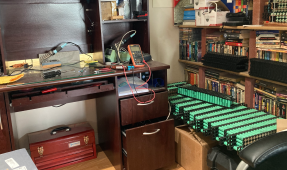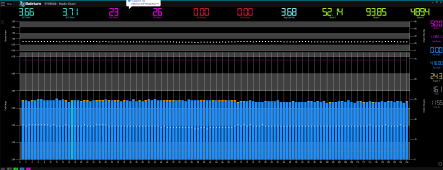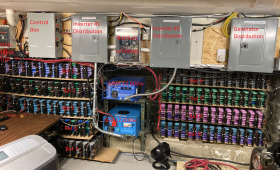Hardware99
New Member
Good Morning/Afternoon/evening (depending on when someone reads this  )
)
I've wanted to get into solar for at least a couple of decades. I was following the tech when ARCO Solar and Solarex were doing booming business in the 90's.
I finally got to the point of getting my system together here in the Kansas City Area. Kudos to Will Prowse and his YouTube channel because that's what got me going again. His review of the EG4 product line really sold me on using an off-grid AIO for my home. A month ago, I was in the hospital when a storm blew through the Kansas City area and we lost power for a bit over 2 days. This just reinforced the need for automatic stand-by power to keep the important stuff going (if it can reduce the utility bill a bit in the process, that's just a bonus).
I don't have a lot of disposable cash, so this had to be built on the cheap, over time (but capable). Enter the EG4 3000EHV-48. There is no way I can run most of my house due to limited panel space on the roof, but a supplement and stand-by power when the utility is down is the way to go for me. This is for my critical loads panel: refrigerator, lights, the furnace, and internet/tv.
Panels that I bought were used 250w Trina Solar - got them in great condition for $83 shipped (a friend and I did a combined buy of 18 - 10 for him, 8 for me)
Batteries were a different subject all together. I didn't have the few thousand dollars for a reasonable amount of LiFePO4 battery storage. I've done a lot of research concerning DIY power walls and went with a 48v, 18650-based battery of my own construction using 1050 cells in a 14s75p configuration. Purchasing new surplus cells over time, l tested all cells at 1A for capacity and temperature (that took a serious amount of time), and with cell-level fusing, creating a 12.5kWh battery bank that can handle up to 75A charge/discharge without issue. Getting ready to get them spot-welded and a JBD BMS to bring it together. Tested and fused, the max draw is 63A and max charge is 80A from the EG4 3000EHV, so well within the cell testing parameters to help prevent overheating, etc.
I'm at a point in my life where going out into the cold to pull-start a 5kW gasoline generator just isn't healthy and dropping $6K-$10K for a whole-home generator just isn't worth it. Gas for run-time gets expensive and nobody will tell you that either.
I look forward to posting pictures when it all comes together.
-Patrick
I've wanted to get into solar for at least a couple of decades. I was following the tech when ARCO Solar and Solarex were doing booming business in the 90's.
I finally got to the point of getting my system together here in the Kansas City Area. Kudos to Will Prowse and his YouTube channel because that's what got me going again. His review of the EG4 product line really sold me on using an off-grid AIO for my home. A month ago, I was in the hospital when a storm blew through the Kansas City area and we lost power for a bit over 2 days. This just reinforced the need for automatic stand-by power to keep the important stuff going (if it can reduce the utility bill a bit in the process, that's just a bonus).
I don't have a lot of disposable cash, so this had to be built on the cheap, over time (but capable). Enter the EG4 3000EHV-48. There is no way I can run most of my house due to limited panel space on the roof, but a supplement and stand-by power when the utility is down is the way to go for me. This is for my critical loads panel: refrigerator, lights, the furnace, and internet/tv.
Panels that I bought were used 250w Trina Solar - got them in great condition for $83 shipped (a friend and I did a combined buy of 18 - 10 for him, 8 for me)
Batteries were a different subject all together. I didn't have the few thousand dollars for a reasonable amount of LiFePO4 battery storage. I've done a lot of research concerning DIY power walls and went with a 48v, 18650-based battery of my own construction using 1050 cells in a 14s75p configuration. Purchasing new surplus cells over time, l tested all cells at 1A for capacity and temperature (that took a serious amount of time), and with cell-level fusing, creating a 12.5kWh battery bank that can handle up to 75A charge/discharge without issue. Getting ready to get them spot-welded and a JBD BMS to bring it together. Tested and fused, the max draw is 63A and max charge is 80A from the EG4 3000EHV, so well within the cell testing parameters to help prevent overheating, etc.
I'm at a point in my life where going out into the cold to pull-start a 5kW gasoline generator just isn't healthy and dropping $6K-$10K for a whole-home generator just isn't worth it. Gas for run-time gets expensive and nobody will tell you that either.
I look forward to posting pictures when it all comes together.
-Patrick






